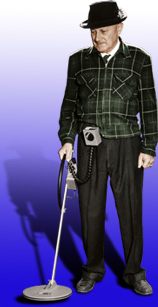(Originally posted on LiveJournal)
I started reading a new fantasy this week and within a couple of pages found myself being irritated. Please don’t take what follows as a review of the whole, because it is not. I mean to push on through before writing anything like that. No, this is just about one point I got snagged on.
 In these early pages, the main character assembles a metal detector and tries it out at a special location. The story is set in 1940, when such contraptions were apparently still new.
In these early pages, the main character assembles a metal detector and tries it out at a special location. The story is set in 1940, when such contraptions were apparently still new.
The problem is that the author describes the assembly of the object as if it were new to the reader. So the term “metal detector” is not used at all. Unfortunately, it makes the paragraph about the assembly boring. (Additionally, I don’t think the description itself fits what a 1940s version would look like – but I’d have to research that, and I haven’t done so yet.)
All of a sudden, I was going, “Look, we (the readers) know what a metal detector is! Don’t keep it a mystery with the generic description of the parts (such as “black box” for “battery”). Show us that it is strange to the character. Make us feel his uncertainty about whether it will work.”
It got me thinking about how “strange objects” are presented, particularly in fantasy. What is the best way to go about doing it?
My feeling is that if the object is known to the characters, I don’t explain it much to the reader. Rather, I just show it in use. Over 15 years ago, in a science fiction script, I had a character doing some work on her home computer, which had an interactive tablet surface built into her desk. This was extrapolated from things already available (my Palm PDA had a recognition program for hand written notes), so it wasn’t all that extreme. But a friend who was into computer hardware design at the time was impressed by what I’d envisioned. Yet, now, tablets for computers do exactly what I’d extrapolated. I’ve been drooling over the Cintiq, where the screen is even pressure sensitive, which makes it a wonderful tool for artists.
Okay, moving away from my raptures over the Cintiq ….
The point is that when is the “myserious object” approach workable, and when isn’t it? What do we want out of that moment? As far as I can tell, in the story I’m reading, although the metal detector is new to the characters, there’s nothing too extraordinary about it. So for me, I’d be more interested in getting a feeling of its newness to the characters, their uncertainty about it. The only time I’d want a “mysterious object” description for a known-to-the-reader object would be when the revelation of what it is makes for a turn in the story.
Am I off my rocker with this? Am I setting too high a standard in my expectations?


